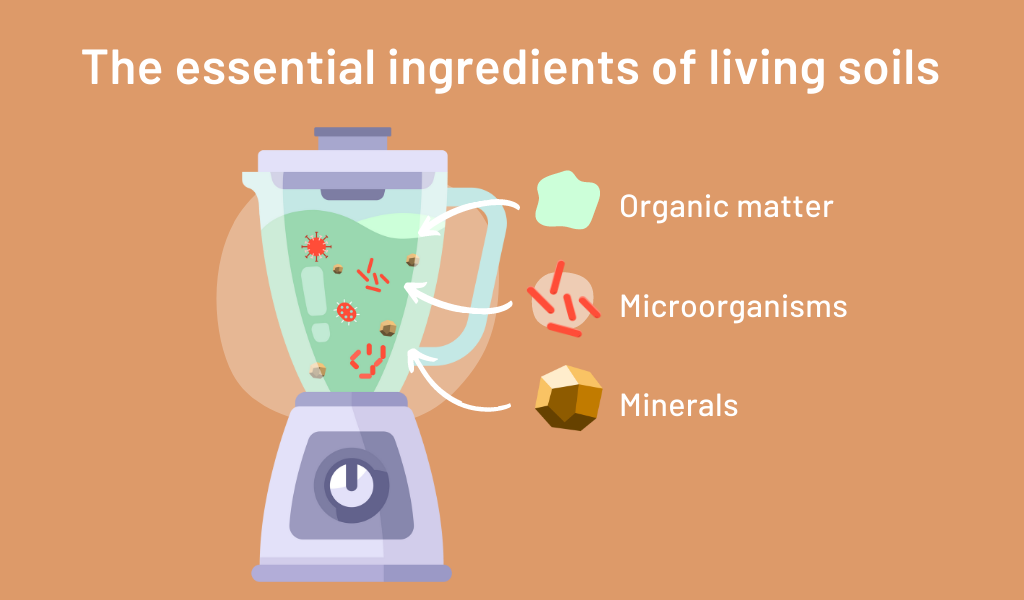Five solutions for soil restoration
The latest IPCC results show an increasingly arid future for the Mediterranean, with less rain and more frequent and longer heat waves. For this reason, the United Nations has focused its efforts on combating soil degradation, desertification, managing our water effectively and sustainably, and caring for the land to prevent it from eroding. With the motto ‘Land. Life. Legacy: From Scarcity to Prosperity’ the 15th COP of the Convention to Combat Desertification is being held in the week of May 9-20, and various sessions are being held to understand and address this crisis. What is being done about it in Spain? Why do we need healthy soil?
Uncontrolled dumping on our soils, massive logging, global nutrient imbalance, and desertification are some examples of the palpable effects of these crises on the land we tread and inhabit.
Society is beginning to face the climate crisis we are in: we are looking for ways to adapt, we are innovating in mitigation measures and we are trying to list possible solutions. One of the handicaps is that the crisis is not just about the climate, it has two more faces: the loss of biodiversity and the massive pollution of soils, water and air. Uncontrolled dumping on our soils, massive logging, global nutrient imbalance, and desertification are some examples of the palpable effects of these crises on the land we tread and inhabit. Biodiversity is also related. Soils are home to 25% of the world's diversity and more than 40% of living organisms in terrestrial ecosystems are associated with it. Thousands of organisms live in the subsoil that suffer from all these changes, intervene in global life cycles and therefore need to be managed on a global scale. Last year, the FAO launched a report on the state of knowledge of terrestrial biodiversity, in which our researcher Pilar Andrés participated as an expert.
In the same way that a person in better health is more resistant to "attacks", a healthy soil is more resistant to adverse effects. We referr to a healthy land as one that really works as a living, dynamic, fertile ecosystem, where plants are born and grow, inhabited by microorganisms, insects and other animals that interact with each other. To maintain this whole chain, the soil must have a desirable proportion of nutrients and a high content of organic matter, which helps to retain water and maintain good moisture. This softens floods, prevents torrential rain from eroding, and helps keep crops and rivers around hydrated in drought conditions. In addition, a healthy soil absorbs more atmospheric carbon, because the microorganisms living in it transform it into organic matter and minerals in the subsoil, becoming a reservoir and reducing its concentration in the atmosphere.

What mechanisms do we have to encourage a soil to be in good health? We present some of the solutions we are studying at CREAF to (re)live the planet's soils.
1. Compound, from the brown container to nourish the soil
We eat a tangerine, remove the skin and throw it in the bucket reserved for organic waste. Our life goes on and once or twice a week we will lower this fraction of the bucket to the brown bin or to the front door. The material inside is called FORM (Organic Fraction of Municipal Waste) and is being monitored by the Waste Agency of Catalonia, which will continue to the composting plants. This is where this organic waste is broken down by a controlled process that includes the action of microorganisms and the presence of oxygen for about 3 months. After that time, voila! We get good compost. "The compost obtained from FORM is a very valuable fertilizer, as it provides the soil with the three M it needs to be considered healthy: microorganisms, organic matter and minerals", according to Meri Pous, of the Waste Agency of Catalonia.
"The use of compost in the soil, as it improves its quality and increases carbon sequestration, can be considered one of the solutions in the fight against climate change and soil degradation", says CREAF researcher Vicenç Carabassa. On the other hand, the use of compost in agriculture is also good news, as it greatly reduces the use of chemical fertilizers and, therefore, the involved cost.
2. Soils on demand
Another restoration technique is newly created soils, called technosoils. These are soils designed and planned to be reclaimed for a specific purpose, such as reforesting an old mine or rehabilitating an agricultural property; they are in a way "soils on demand". To create them, different organic materials are applied that improve the soil's health, one of which is compost, and which are known as organic amendments.
From CREAF, "we have been studying these amendments for years with the Waste Agency of Catalonia, because we need to know their behaviour on each soil, what doses are needed to restore them, if they help retain carbon and improve the ecosystem services in general", according to Vicenç Carabassa. "In our team we have researched it historically with sewage sludge, those that come from wastewater treatment plants and that are also amendments. We have studies for more than 25 years, pioneered by CREAF researcher Josep Maria Alcañiz, also a professor at the UAB. And on 2022 we are expanding them with other organic and mineral waste in experimental plots in Garraf (Barcelona) to restore the soil of landfills, quarries and other degraded land".
Biochar is another material that can be applied to recover soils. It is obtained from plant debris and biomass waste and is applied directly to the soil, does not burn like conventional charcoal, and improves its fertility and stimulates microbial activity.
3. Regenerative agriculture and forestry
"A country that does not have fertile land is not able to produce food or decide on its own agricultural and food policies. Recovering lost fertility allows us to promote food sovereignty and produce quality food without the control of large external lobbies", explains Marc Gràcia, coordinator of the European Polyfarming project. The way we eat is clearly linked to the health of the land we inhabit. In fact, overgrazing and intensive agriculture are among the most damaging human activities for land quality. An alternative to the intensive practices is regenerative agriculture, which focuses on caring for the soil and restoring its fertility. In this way, the food we generate will be sustainable, while improving the health of farms. CREAF research on Polyfarming shows that a regenerative agriculture vegetable garden absorbs up to 30 times more CO2 per year than a conventional one. It also improves the water retention capacity by 20%, and multiplies the amount of organic matter. We are therefore facing a solution to progressively recover degraded soils and offset annual emissions from the agricultural sector.
Regenerative agriculture vegetable garden absorbs up to 30 times more CO2 per year than a conventional one. It also improves the water retention capacity by 20%, and multiplies the amount of organic matter.
Livestock must also be part of a more responsible consumption, which is why we are involved in regenerative and/or extensive livestock projects. The Mediterranean landscape is becoming more homogeneous and it is detrimental to soil health, which has no diversity of fauna and flora, is more at risk of fire and loses its ability to retain water. Extensive grazing practices would be a way to reverse this situation, as they diversify the landscape and its needs and allow us to prepare for the even greater increase in temperatures expected in the Mediterranean basin. Moreover, if designed from a regenerative perspective, livestock farming would not only be used to restore the mosaic landscape we need, but also to restore fertile soil. "Through studies with the fields4ever initiative we are comparing in Menorca the biodiversity of fungi and bacteria that soils with intensively managed pastures have versus sustainable pastures to see how it influences carbon sequestration in the soil," explains CREAF researcher Pilar Andrés, project leader and expert in soil ecology.

4. Biodegradable solutions for reforestation
A CREAF team in collaboration with international experts is testing the effectiveness of biodegradable devices for replanting desertified or highly degraded areas. They are known as ‘Cocoon’ and are a method that has been used to replant about 30,000 trees in the Mediterranean area –Catalonia, Valencia, Almeria, Italy and Greece– and the Canary Islands with high seedling survival efficiency. These cardboard solutions are buried in the ground full of water and moisturize and protect the tree during the first year of life, the most sensitive, and then decompose in the ground.
The results of recent years are very positive, as this method can become a good solution to reforest an area that has lost soil quality and needs a push. It should be noted, as we said at the beginning of the text, that episodes of extreme aridity will become more frequent and that good reforestation, scheduled and focused in each region, will be very necessary. In Catalonia, for example, attempts have been made to replant a burned area in El Bruc (Barcelona) and 60% of the trees have survived, twice as many as with traditional methods. In addition, economically, studies around the Cocoon have shown that the method can be up to 4 times more profitable also in comparison. The actions have been carried out with the support of the Cabildo of Gran Canaria and the company GESPLAN.

5. Collecting fog
It may seem unbelievable, but the latest solution we present is based on droplets of fog water. Thanks to the LIFE Nieblas project, researchers collect fog and dew from the humid environments of Gran Canaria, and use them to recover the forests and aquifers of 35 hectares of the island. The aim is to collect 215,000 litres of water and, once its effectiveness has been demonstrated, it is planned to implement it in the Mediterranean basin and in Portugal to combat desertification. The areas chosen for rehabilitation in Gran Canaria had been severely degraded by centuries of logging and massive water extraction from the aquifers and by a devastating fire. Once the project is completed, they will enjoy species endemic to the area and typical of the laurel forest, such as beech and Canary Island holm oak. Restoring good vegetation to degraded soil helps to maintain its structure, as the roots become strongly anchored, generating a cycle of organic matter that can help to restore fertility. In addition, living soils in which diverse plants grow retain water better and help to maintain optimum humidity, even if it doesn’t rain.
However, while we have five solutions to try to mitigate the effects of global warming on the earth, we should not rely on it. Many environmental restoration studies are being done to restore the health of our soils, but they never return –or take many years– to become like a primary soil, so the key is still to take care of them and preserve their health to prevent them from dying.
More about it in Castilian:







